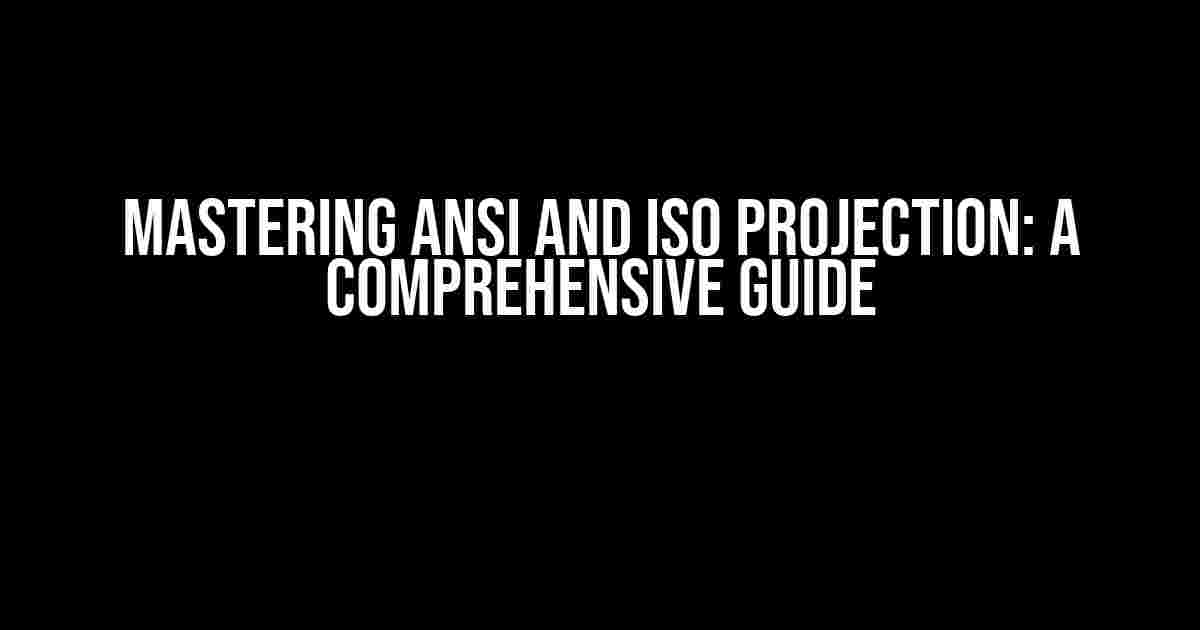Are you tired of dealing with projection headaches? Do you struggle to understand the differences between ANSI and ISO projection? Look no further! In this article, we’ll dive deep into the world of projection standards, exploring the ins and outs of ANSI and ISO projection. By the end of this journey, you’ll be a master of projection standards, ready to tackle any project that comes your way.
What is ANSI Projection?
The American National Standards Institute (ANSI) is a private, non-profit organization that develops and publishes standards for a wide range of industries. In the world of projection, ANSI plays a crucial role in setting standards for projection systems. ANSI projection, also known as American National Standards Institute projection, is a standard that outlines the specifications for projection systems used in the United States.
The ANSI standard for projection (ANSI/ANSI PH3.40-1984) provides guidelines for the design, manufacture, and testing of projection systems. This standard covers aspects such as screen size, aspect ratio, and resolution, ensuring that projection systems meet the required specifications for optimal performance.
Advantages of ANSI Projection
- Wide compatibility: ANSI projection is widely used and supported, making it easy to find compatible equipment and accessories.
- High-quality images: ANSI projection ensures high-quality images with accurate color representation and good contrast ratio.
- Flexible screen sizes: ANSI projection supports a wide range of screen sizes, from small to large, making it suitable for various applications.
What is ISO Projection?
The International Organization for Standardization (ISO) is an independent, non-governmental organization that develops and publishes standards for a wide range of industries. In the world of projection, ISO plays a crucial role in setting standards for projection systems globally.
The ISO standard for projection (ISO 14839:2002) provides guidelines for the design, manufacture, and testing of projection systems. This standard covers aspects such as screen size, aspect ratio, and resolution, ensuring that projection systems meet the required specifications for optimal performance.
Advantages of ISO Projection
- Global compatibility: ISO projection is widely adopted globally, making it easy to find compatible equipment and accessories across different regions.
- High-quality images: ISO projection ensures high-quality images with accurate color representation and good contrast ratio.
- Seamless integration: ISO projection enables seamless integration with other ISO-compliant devices and systems, making it ideal for global applications.
Key Differences between ANSI and ISO Projection
While both ANSI and ISO projection standards share some similarities, there are key differences between the two. Here are the main differences:
| Characteristic | ANSI Projection | ISO Projection |
|---|---|---|
| Screen Size | Up to 40 feet (12.2 meters) | Up to 60 feet (18.3 meters) |
| Aspect Ratio | 4:3 or 16:9 | 4:3, 16:9, or 2.39:1 |
| Resolution | Up to 2048×1080 pixels | Up to 4096×2160 pixels |
| Color Gamut | NTSC or PAL color gamut | Rec. 709 or DCI-P3 color gamut |
When to Use ANSI Projection
ANSI projection is ideal for:
- Small to medium-sized screens
- Home theaters or small commercial applications
- NTSC or PAL-based systems
When to Use ISO Projection
ISO projection is ideal for:
- Large screens or high-brightness applications
- Global or international projects
- DCI-compliant or 4K-based systems
Setting Up an ANSI or ISO Projection System
Setting up an ANSI or ISO projection system requires careful planning and attention to detail. Here’s a step-by-step guide to help you get started:
- Determine the screen size: Choose a screen size that meets the ANSI or ISO standard for your application.
- Select the projection technology: Choose a projection technology that supports the desired resolution and aspect ratio (e.g., LCD, LED, or laser).
- Choose the projector: Select a projector that meets the ANSI or ISO standard and supports the desired resolution and aspect ratio.
- Set up the projector: Follow the manufacturer’s instructions to set up the projector, ensuring it is installed at the correct distance from the screen.
- Calibrate the projector: Calibrate the projector to ensure optimal image quality and color accuracy.
- Test the system: Test the projection system to ensure it meets the required specifications and standards.
Troubleshooting Common Issues
Like any complex system, ANSI and ISO projection systems can experience issues. Here are some common problems and their solutions:
- Image distortion: Adjust the projector’s keystone correction or consider using a different screen material.
- Color inaccuracies: Calibrate the projector using a color calibration tool or consult the manufacturer’s instructions.
- Screen deterioration: Clean the screen regularly and consider using a screen protection filter.
Conclusion
In conclusion, mastering ANSI and ISO projection requires a deep understanding of the standards and their applications. By following the guidelines and best practices outlined in this article, you’ll be well on your way to becoming a projection expert. Remember to choose the right standard for your application, set up your system correctly, and troubleshoot any issues that arise. With practice and patience, you’ll be projecting like a pro in no time!
Remember, ANSI and ISO projection standards are not mutually exclusive. In many cases, projection systems may support both standards, depending on the application and requirements.
By embracing the world of ANSI and ISO projection, you’ll unlock a universe of possibilities, from stunning home theaters to breathtaking cinematic experiences. So, what are you waiting for? Start projecting today!


